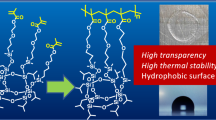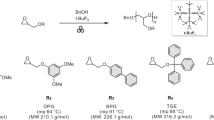Abstract
In olefin polymerization using methylaluminoxane (MAO) as a cocatalyst, the remaining trialkylaluminum (R3Al) in MAO sometimes leads to negative effects, such as a decrease in activity and molecular weight of the obtained polymer. Thus, in this study, the amount of R3Al in modified MAO (MMAO) was reduced by using a crosslinked terpolymer bearing bulky phenoxy groups as a solid support for R3Al. The R3Al removal efficiency of the terpolymer at a certain hydroxy group content was found to be much higher than that of SiO2, which has been previously reported to be an efficient R3Al remover. This is probably because of the steric bulkiness around the hydroxy groups and because some R3Al is physically adsorbed into the terpolymer. The chain transfer reaction derived from residual R3Al in propylene polymerization is mostly suppressed after the treatment of MMAO with the terpolymer.
This is a preview of subscription content, access via your institution
Access options
Subscribe to this journal
Receive 12 print issues and online access
$259.00 per year
only $21.58 per issue
Buy this article
- Purchase on Springer Link
- Instant access to full article PDF
Prices may be subject to local taxes which are calculated during checkout







Similar content being viewed by others
References
Kaminsky W. Discovery of methylaluminoxane as cocatalyst for olefin polymerization. Macromolecules. 2012;45:3289–97.
Zijlstra HS, Harder S. Methylalumoxane—history, production, properties, and applications. Eur J Inorg Chem. 2015;2015:19–43.
Hagimoto H, Shiono T, Ikeda T. Living polymerization of propene with a chelating diamide complex of titanium using dried methylaluminoxane. Macromol Rapid Commun. 2002;23:73–6.
Tynys A, Eilertsen JL, Rytter E. Zirconocene propylene polymerisation: controlling termination reactions. Macromol Chem Phys. 2006;207:295–303.
Rocchigiani L, Busico V, Pastore A, Macchioni A. Probing the interactions between all components of the catalytic pool for homogeneous olefin polymerisation by diffusion NMR spectroscopy. Dalton Trans. 2013;42:9104–11.
Ehm C, Cipullo R, Budzelaarb PHM, Busico V. Role(s) of TMA in polymerization. Dalton Trans. 2016;45:6847–55.
Guo Y, Fu Z, Xu J, Fan Z. Structure and properties of ethylene/propylene copolymers synthesized with bis(2,4,7-trimethylindenyl)zirconium dichloride activated by methyl aluminoxanes containing different amount of trimethylaluminum. Polymer. 2017;122:77–86.
Wu FJ, Simeral LS, Mrse AA, Eilertsen JL, Negureanu L, Gan Z, et al. Structural characterization of Al10O6iBu16(μ-H)2, a high aluminum content cluster: further studies of methylaluminoxane (MAO) and related aluminum complexes. Inorg Chem. 2007;46:44–7.
Henderson MA, Trefz TK, Collins S, Wang MY, McIndoe JS. Characterization of isobutylaluminoxanes by electrospray ionization mass spectrometry. Organometallics. 2013;32:2079–83.
Falls Z, Tymińska N, Zurek E. The dynamic equilibrium between (AlOMe)n cages and (AlOMe)n·(AlMe3)m nanotubes in methylaluminoxane (MAO): a first-principles investigation. Macromolecules. 2014;47:8556–9.
Zijlstra HS, Joshi A, Linnolahti M, Collins S, McIndoe JS. Modifying methylalumoxane via alkyl exchange. Dalton Trans. 2018;47:17291–8.
Teixeira VE, Livotto PR. The mechanism of the reaction between MAO and TMA: DFT study of the electronic structure and characterization of transition states for [AlOMe]6, [AlOMe]9 and [AlOMe]16 cages. J Mol Graph Model. 2020;99:107626.
Joshi A, Zijlstra HS, Liles E, Concepcion C, Linnolahti M, McIndoe JS. Real-time analysis of methylalumoxane formation. Chem Sci. 2021;12:546–51.
Tanaka R, Kawahara T, Shinto Y, Nakayama Y, Shiono T. An alternative method for the preparation of trialkylaluminum-depleted modified-methylaluminoxane (dMMAO). Macromolecules. 2017;50:5989–93.
Busico V, Cipullo R, Cutillo F, Friederichs N, Ronca S, Wang B. Improving the performance of methylalumoxane: a facile and efficient method to trap “free” trimethylaluminum. J Am Chem Soc. 2003;125:12402–3.
Zaccaria F, Zuccaccia C, Cipullo R, Budzelaar PHM, Macchioni A. On the nature of the Lewis Acidic Sites in “TMA-Free” phenol-modified methylaluminoxane. Eur J Inorg Chem. 2020;11-12:1088–95.
Tanaka R. Precise control of coordination polymerization via the modification of methylaluminoxane (MAO). Polym J. 2020;52:661–70.
Zaccaria F, Budzelaar PHM, Cipullo R, Zuccaccia C, Macchioni A, Busico V, et al. Reactivity trends of lewis acidic sites in methylaluminoxane and some of its modifications. Inorg Chem. 2020;59:5751–9.
Nishii K, Hagihara H, Ikeda T, Akita M, Shiono T. Stereospecific polymerization of propylene with group 4 ansa-fluorenylamidodimethyl complexes. J Organomet Chem. 2006;691:193–201.
Parker DK. Process for preparing hindered alkenyl phenols. 1978; US4072724.
Chen MC, Roberts JAS, Marks TJ. Marked counteranion effects on single-site olefin polymerization processes. correlations of ion pair structure and dynamics with polymerization activity, chain transfer, and syndioselectivity. J Am Chem Soc. 2004;126:4605–25.
Hasegawa H, Higashimura T. Synthesis of linear poly(divinylbenzene) through proton-transfer polyaddition by oxo acids. Macromolecules. 1980;13:1350–4.
Ouardad S, Deffieux A, Peruch F. Polyisoprene synthesized via cationic polymerization: state of the art. Pure Appl Chem. 2012;84:2065–80.
Bicerano J, Sammler RL, Carriere CJ, Seitz JT. Correlation between glass transition temperature and chain structure for randomly crosslinked high polymers. J Polym Sci Part B: Polym Phys. 1996;34:2247–59.
Hasan T, Ioku A, Nishii K, Shiono T, Ikeda T. Syndiospecific living polymerization of propene with [t-BuNSiMe2Flu]TiMe2 Using MAO as Cocatalyst. Macromolecules. 2001;34:3142–5.
Jahnert T, Hager MD, Schubert US. Application of phenolic radicals for antioxidants, as active materials in batteries, magnetic materials and ligands for metal-complexes. J Mater Chem A. 2014;2:15234–51.
Endres E, Zijlstra HS, Collins S, McIndoe JS, Linnolahti M. Oxidation of methylalumoxane oligomers: a theoretical study guided by mass spectrometry. Organometallics. 2018;37:3936–42.
Acknowledgements
This work was financially supported by the Iwatani Naoji foundation. The generous donation of MMAO from Tosoh-Finechem Co. (Japan) is greatly acknowledged. The authors are also grateful to the Digital Manufacturing Education and Research Center for high-temperature GPC measurements and TG-MS analysis.
Author information
Authors and Affiliations
Corresponding authors
Ethics declarations
Conflict of interest
The authors declare no competing interests.
Additional information
Publisher’s note Springer Nature remains neutral with regard to jurisdictional claims in published maps and institutional affiliations.
Supplementary information
Rights and permissions
About this article
Cite this article
Tanaka, R., Nishizono, M., Nakayama, Y. et al. Removal of mononuclear alkylaluminum species in aluminoxane using a crosslinked polymer bearing bulky phenoxy groups. Polym J 53, 1187–1193 (2021). https://doi.org/10.1038/s41428-021-00507-w
Received:
Accepted:
Published:
Issue Date:
DOI: https://doi.org/10.1038/s41428-021-00507-w



